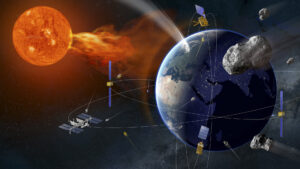
With the number of satellites in orbit rising fast from just 1,000 a few years ago to nearly 6,000 today experts warn of growing risks from space weather. More than 100,000 new satellites are expected to launch in the next five years, increasing the importance of protecting space technology from harmful solar activity.
Many new satellites are built using off-the-shelf parts, making them less durable than older, larger spacecraft. This means they are more vulnerable to space weather natural disturbances caused by solar activity that can affect satellites, communications, navigation systems, and even power grids on Earth.
Space weather can damage satellites through radiation, disrupt GPS signals by disturbing the ionosphere, and cause unexpected changes in the Earth’s upper atmosphere, making it harder to predict satellite orbits and track space debris. Strong solar storms can also trigger electrical currents that damage transformers in ground-based power grids.
To protect technology in space and on Earth, experts stress the need for real-time space weather warnings. These warnings allow satellite operators to delay maneuvers, pause software updates, or activate protective modes before damage occurs. However, such alerts must offer enough advance notice, include clear risk levels, and be easy to understand.
Two European Union-funded projects PROGRESS and PAGER have created new prediction tools that offer this crucial information. These tools, now available on the PAGER website (https://www.spacepager.eu/data-products), provide the first-ever complete forecasting system that links solar activity with effects on Earth magnetosphere and ground infrastructure. They also include confidence levels to help decision-makers understand the likelihood of events.
Building on this, the FLAG project (Forecasts and Long-term probabilistic data Assimilative prediction of the effects of Geomagnetic storms) aims to deliver even better forecasts. By using advanced models and machine learning, FLAG will produce highly accurate, long-term predictions of space weather impacts.
The final result will be a simple “traffic light” warning system showing green, yellow, or red indicators to tell satellite operators if their spacecraft are at risk. These warnings will be tailored to each satellite’s orbit and materials, making them practical and easy to use.
Professor Yuri Shprits of the University of Potsdam, who leads the project, says it is vital for Europe to have its own independent space weather forecasting system, especially given changing international conditions. “With the shifting situation in the US, it’s more important than ever for Europe to rely on its own tools for space weather prediction,” he said.
The FLAG project will support the European Space Agency (ESA) by making these advanced forecasts operational, helping to protect Europe’s growing presence in space.
